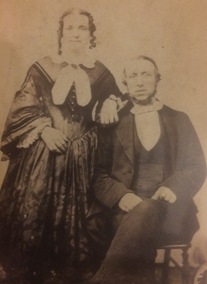 |
|
Eliza Ann's parents, Samuel Cheetham and Ann Hartley had both died of typhus on the same day in 1862, leaving seven children aged from 1 to 11 years old, Thereafter the children had been cared for by Ann's sister Betsy who continued to operate their pawnbroker business at 70 Cheetham Street. Eliza Ann had been just 6 years old when her parents died.
Their family is here: link to Family of Eliza Ann Cheetham in Rochdale |
 |
|
John Lawrie and his brother Robert came to Rochdale from Tillicoultry in around 1876 or 1877.
Their family is here: link to Family of Hugh Lawrie in Tillicoultry, Clackmannan
John married Eliza Ann Cheetham on September 1st 1878. The births of their children were recorded at 44 Yorkshire Street, Rochdale where John and Eliza Ann had six children, from Hugh in 1879 to Clarence in 1888, with one dying in infancy.
John Lawrie died in July 1890, leaving Eliza Ann with five children between 2 and 11 years old. Aunt Jean who was 16 in 1934 when Eliza Ann died, would have known her grandmother. She told me that John's brother Robert (married to Ann Broughton in Burnley) took over the boot business, leaving Eliza Ann with nothing. In those days of the Poor Law, a widow with five dependent children would very often find it necessary to apply for Poor relief with means-testing and the other indignities which that entailed.
A very helpful lady at the Rochdale Local Studies team advised me, after consulting the surviving records, that there was no record of Eliza Ann receiving any poor relief. I have to assume that she had been supported by her sister, Betsy, from the pawnbrokers at 70 Cheetham Street which was still operating according to the 1871 census although it was not listed in the 1879 Street directory. However, John Forbes would not have had an easy childhood. He was listed in the 1901 census as a news boy, aged 14, so clearly had left education.
In the picture, probably dated late in 1888 before John's death in 1890. Brother Robert is standing.
From left to right: John Lawrie with John Forbes (b.1886) in front of him, Hugh Hartley (b. 1879) holding the dog, Eliza Ann Cheetham holding her youngest child, Clarence Ferguson (b.1888), Samuel MacFarlane (b.1881) standing and Robert Cheetham (b.1884) seated in front.
|
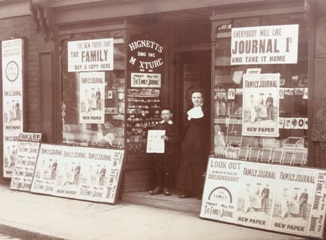 |
|
In the 1891 cenus, Eliza Ann was recorded at Buckley Street, Rochdale with her five children. In 1901 she was at Longford Street with Hugh, Robert, John and Clarence. By 1911, Eliza Ann was a newsagent in Durham Street, Rochdale, shown here outside her shop. The photograph is undated and I do not know who the boy alongside her might be. I discovered that the first edition of "The Family Journal" was published on the 8th of May 1909, so that would date this photograph. The boy is too young to be any of Eliza Ann's children. (Clarence, the youngest, would have been 21 in 1909). Her eldest son Hugh had married Amy Elizabeth in 1904. Hugh and his wife appeared in the census of 1911 in Manchester Gorton, with his profession stated as Medical botanist. (Hugh would, late in his life, became MP for Rochdale in the Labour landslide of 1945). They had sons John, aged three and Hugh, aged one in 1911, so it could not have been either of them. The remaining possibility is that he was one of her Cheetham nephews, perhaps Arthur Bright's son Ernest, or one of Eleanor Anne Browne's four sons.
What of the other children, as none of them appeared with Eliza Ann in the 1911 census? Samuel married Lizzie in 1910 and resided at Eccles, Patricroft. His profession was blacksmith. Clarence had joined the navy and I found him at Devonpart dockyard. John Forbes was by now a newsagent in his own right, as illustrated below, in Moston Lane, Blackley, with his first child born in 1910. I could not find Robert in the 1911 census. |
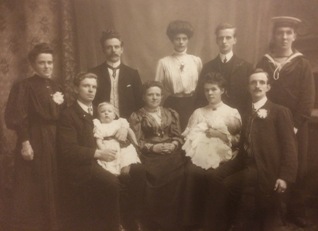 |
|
This undated family portrait celebrates the baptism of Hugh and Amy's second son in 1910.
Front row left to right: Hugh Hartley Lawrie with son John; proud grandmother Eliza Ann; Amy with her newly baptised son Hugh; Robert (I think this is brother Robert Cheetham Lawrie.
Back row left to right: Lizzy with Samuel Lawrie; Laurie Helen and John Forbes Lawrie; Clarence Ferguson in his naval uniform. |
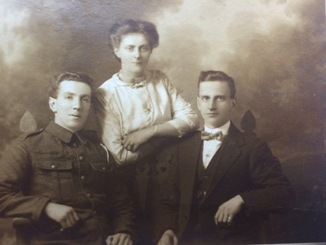 |
|
This portrait has Clarence in his military uniform, Laurie Helen and John Forbes Lawrie. Clarence was born in 1888. In the 1911 census he was at Devonport, ranked as a stoker, RN. Although he was in the Navy, he wears an army style khaki uniform as he was in the Howe battalion of the Naval Brigade, which was a formation raised at the start of WW1 in 1914 to serve on land. In Jean's papers I found a cutting from a local Rochdale Newspaper which Jean had kept. Clarence had been sent to Turkey to participate in the Gallipoli landings where he died on June 3, 1915. In a letter from him dated May 1915 and also published in the newspaper, he wrote:
"Sometimes one sees pictures of a battlefield. They are all wrong. In fact one could not reconcile pictures with the real thing. In battle we are like a lot of human rabbits burrowed in against shellfire and shrapnel."
This photograph is therefore dated after August 1914 and before May 1915 when he arrived at the Darndanelles. |
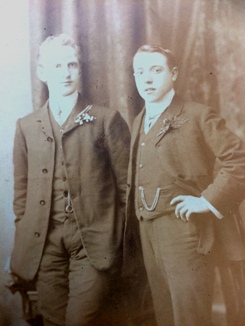 |
|
This photograph is undated but shows John Forbes Lawrie on the left and a friend John Budge
The flowers in their lapels, suggests that this photograph may have been taken at a marriage, perhaps JF's marriage to Laurie Helen MacGregor on 29th October 1908 |
 |
|
According to the Manchester street directory of 1909, JF Lawrie operated a tobacconist shop at 153 Rochdale Road. The adjoining picture which I found among the papers from Jean, is marked 153 Rochdale Road on the rear with a comment that he "left in December 1909". The shop front is headed "T Kinsey" and this could be Mr Kinsey standing in the doorway or perhaps a customer. One might, therefore, assume that the picture is dated from before JF took it over, although it appears from the reference below that the shop retained the name "T Kinsey" in the 1930s..
153 Rochdale Road is the address given on the marriage certificate of JF Lawrie and LH MacGregor on 29th October 1908.
The family of Laurie Helen MacGregor is here: link to the MacGregor family in Weaverham, Cheshire
I noted in "Different Times" by WK Jones, page 146, that Kinsey's shop on Rochdale Road was near the corner of Whitley Street. The book describes the poverty-stricken life of the people living in the area around the lower part of Rochdale Road in the 1930s.
As far as I can determinel from Google maps, the actual site of 153 Rochdale Road is now part a huge car-park. |
 |
|
According to the Manchester Street directories, from 1910 until 1919, JF Lawrie had a Newsagent's shop at 29 Moston Lane . The adjoining picture must be this. Standing in the doorway, according to Jean's note on the back was John Forbes with his brother Clarence. Helen Ida (born May 1910) and Edith Annie (December 1911) were registered in Prestwich/Blackley, while the family presumably lived above the shop.
Tthe birth of Clarence was registered in October 1915 in Prestwich/Blackley when the family were still at Moston Lane. However, Jean was registered in October 1918 at Prestwich/Failsworth, suggesting that the family had actually moved to 135 Church Lane by then, despite the street directory recording them still in Moston Lane in 1919. John was also registered in Prestwich/Failsworth in March 1920. Failsworth itself lies between Newton Heath and Moston. 135 Church Lane must therefore fall in the Prestwich/Failsworth district and that shop must have been where John and Jean were born..
Their last child, Laurie Helen ("Billy") was born in November 1922, but registered at Birkenhead/Wallasey. Paul Miller McGregor, Laurie Helen's father, had lived at Garston, across the Mersey from Birkenhead from 1908 until his death in 1925. I believe her brothers Malcolm and Duncan may have been in business somewhere near Wallasey or Birkenhead. However, LH's sister, Emma Ida, residing at 31 Hillcroft Road, Wallasey, was a trained nurse. Ida had been widowed when husband Austin McDonald had been killed on Western Front 6th June 1917. Ida had sons Hector and Bay who appear below in the 1929 photograph at Glen Villa. |
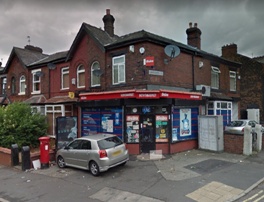 |
|
The Manchester archivist kindly provided me with information from the street directories. From 1920 until 1924 JF Lawrie was recorded as a , Newsagent, at 135 Church Lane, Harpurhey.
From 1874, Blackley, Harpurhey and Failsworth formed part of the Prestwich registration district, but from 1925 they all came under Manchester North district.
The shop at 29 Moston Lane has gone and was presumably demolished as part of the general clearances of the 1960s and 1970s. However, according to the adjoining picture from Google street view, there is still a Newsagents at 135 Church Lane, Harpurhey. In which case, Jean and John were born here in this Edwardian corner shop with family living accommodation above. It would be crowded for a family of 8 when Billy arrived in 1922.
Glen Villa, which lay less than 100 yards away to the west along Church Lane, would have provided lots of space for the family.
Click on the image for a larger view.
|
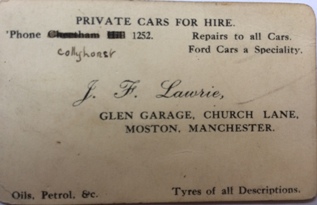 |
|
From the date of the 1925 street directory, the family were at 1 Glen Villas in Church Lane, Harpurhey with the adjoining Glen Garage. John Forbes Lawrie was described as a motor engineer. Perhaps the move from Newsagent to Motor Engineer would have been simpler in the 1920s as I have found no record of JF training as such!
It appears that JF may have taken over an going garage concern as the street directories for 1920 to 1924 records Thomas Henderson, motor engineer, at Glen Villas. John Lawrie's marriage certificate in 1946 gives his usual address as 122 Church Lane, but in the street directory for 1933 the confectionery shop (shown in the 1950 image below with Jean standing outside) is listed as 108 Church Lane.
An undated clipping from a local newspaper in Jean's papers concerned Edith Annie, their second child, (who would die of pulmonary TB on 17/4/1930 at the age of 18). The extract reported that Edith had been in the wooden office of the garage when an oil stove overheated and burst into flames. The report stated that Edith was 16, so this probably happened during 1928. Edith phoned her mother at the house for help. By the time she escaped the flames she had suffered burns to her face and hands. A passer-by successfully operated the extinguisher so that the fire was almost under control by the time the fire brigade arrived. The nearby chemist provided first aid before Edith was taken to Ancoats hospital by ambulance. She was allowed home after treatment.
As the card shows, the Glen Garage sold petrol, offered repairs for all cars, especially fords; supplied tyres and provided cars for hire. JF also operated a local haulage business, perhaps using army surplus trucks after 1945. As a child I remember playing on the remains of a number of trucks parked alongside the house. The haulage business was sold to a Mr Taylor in November 1954. As the Glen Garage does not appear in the street directory from 1954 onwards, it has to be assumed that the garage business closed at the same time. JF would have been 68 in 1954. |
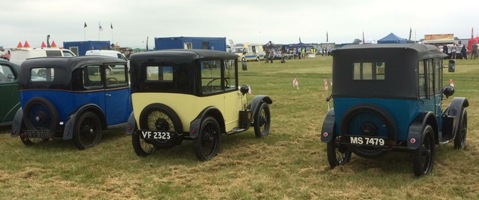 |
|
As Jean did not save any photographs of the garage, I have, instead, included a photograph of my blue 1933 Austin seven saloon, VT9016, along with two others at a 2018 classic car show. These would have been typical of the cars frequenting the Glen Garage. The equivalent "baby" Ford was the 2-door, 933cc "Eight" on the right.
By the late 1950s when I remember Glen Villa, the garage had gone, but a row of wooden lock-ups remained which, I believe, were rented out. |
|
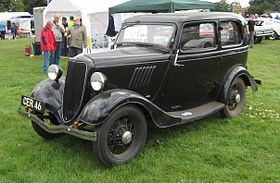 |
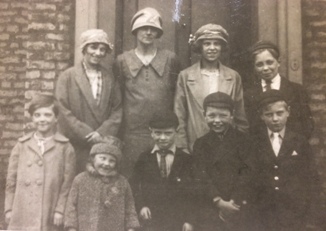 |
|
In this image, with 1929 written on the rear, the whole family is pictured outside Glen Villa.
At the rear left is Helen Ida ("Ida", aged 19); mother Laurie Helen MacGregor); Edith Annie ("Edith", aged 17); and cousin Hector MacDonald. In front, Jean Laurie ("Jean", aged 11); Laurie Helen ("Billy", aged 6); John (he called himself "Plain" John, aged 8); Bay MacDonald and Clarence Forbes ("Clarence", aged 14).
There are very few photographs of Edith, she died in April 1930.
|
 |
|
This is Glen Villa from the street side with the baker's shop. I find it difficult to estimate its age. It could be early Victorian, but definitely not a Georgian style of house. As shown in the 25-inch map below, it was actually built as two semi-detached houses. Grandfather owned both. The garage and lockups are to the west.
Behind the house was a wooded glen with the headwaters of the Moss Brook which fed into the Moston Brook. The grounds were extensive. The OS map indicates, roughly a triangle, with a baseline frontage on Church Lane of around 130 yards and going back to an apex downstream of at least 150 yards and possibly more. The entire site has now been levelled and the glen partly infilled for Thorntree Close, a modern housing development.
The 'glen' is still there as the Google Earth image on the right shows.
|
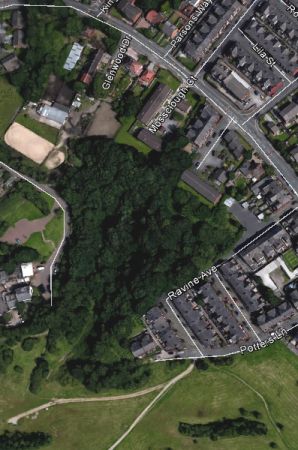 |
|
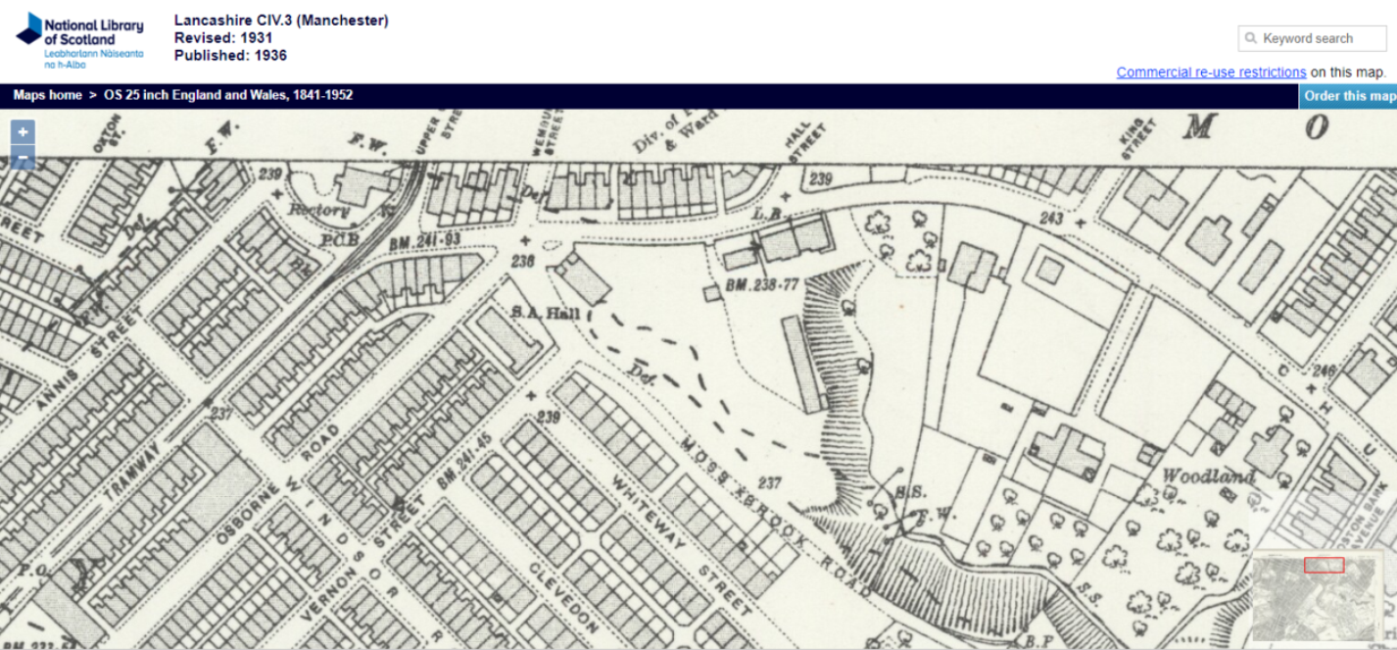 |
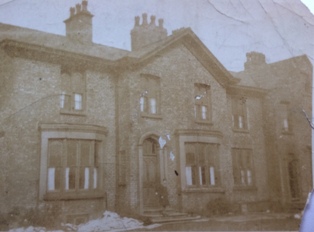 |
|
A view of Glen Villa from the garden side. The photograph is in poor condition. I can't make out who is standing on the steps.I remember a lovely flower garden kept by Jean with lupins and peonies, but there are no photographs.
In the "History of the Ancient chapel of Blackley", by John Booker, I found -. "In an indenture bearing date January 2nd 1812 .... William and Henry Hulton and William Cross grant ... to Robert Andrew the messuage ... situate in Harpurhey together with the several closes or fields thereunto belonging: ..... ..... and also all that river or stream of water called the Moss Brook .... Having completed the purchase, Mr Andrew erected thereon an elegant and comodious mansion, in which he continued to reside until his death, June 9th, 1831."
In discovery.nationalarchives.gov.uk/GB2008 CD4-3.pdf, William Hargreaves of Glen Villa, Harpurhey, Manchester is included in a draft conveyance CD4/11/34/19 of June 10 1878.
It is not possible to be certain, but as the Glen Villa land included the Moss Brook, it may well be that Glen Villa is that "elegant and comodious mansion" erected in 1812 by Robert Andrew. After 150 years and the complete change in the locality from a leafy rural area to an industrialised, smoky and overcrowded suburb, I would not have described it as 'elegant' but it was certainly commodious, in contrast to the two-up-two-down terraced houses which were erected all around at the end of the century when the new electric trams arrived.
|
 |
|
John (and, presumably, Clarence, his older brother), attended Lily Lane boys school. The evidence is in the Form 1 photograph opposite which is dated 1931. I don't know when he left. Click for a full size image.
The next image we have of John is a group photograph when he joined the RAF in April 1940. |
 |
|
Apparently having a picnic. The houses behind do not appear to be those I remember around Glen Villa.
The photograph is undated, but on the back Jean has written "Mr & Mrs J F Lawrie and John Lawrie". If the boy on the left is my father, John, it must be around 1930, with grandmother passing a tidbit to grandfather. |
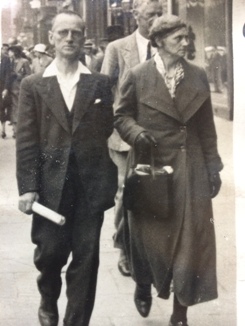 |
|
JF and LH out walking, perhaps shopping, sometime in the 1930s or early 40s. |
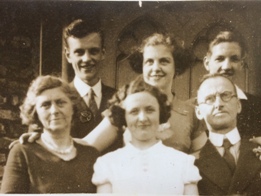 |
|
On the left is a family picture at Glen Villa dated 1939. At the back is brother & sister, John and Jean with their cousin Harold, the son of Robert Cheetham Lawrie. In front is Mrs Laurie Helen Lawrie, Harold's sister Ethel and John Forbes Lawrie on the right., |
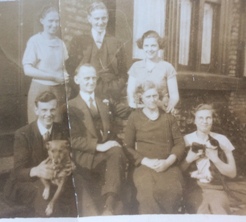 |
|
This photo is a 3" by 2" print which has been creased, so it is not very clear. I am guessing that it dates from about 1939. At the rear left is Ida (aged ~30 - she married in 1941); Clarence Forbes (~25); Jean (~22). At the front John (~20) with the dog; JF and LF and finally Helen (~18) with the cats. |
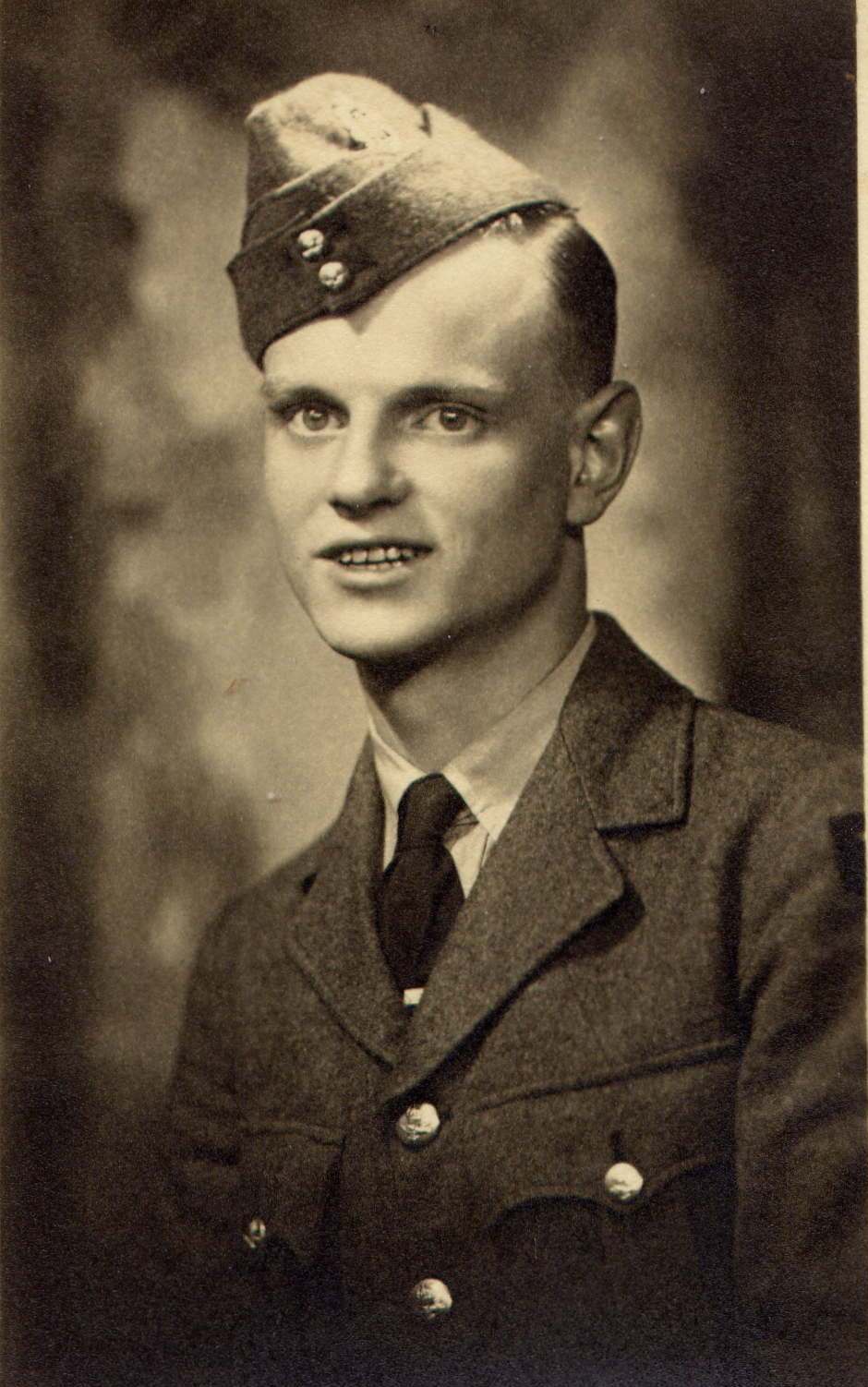 |
|
The image is of my father, John, in RAF uniform, possibly in 1940. John told me in 1969 before he died that he had served as RAF ground crew, maintaining aircraft in Egypt, Libya, Palestine and Kenya. He said about his postings in Libya and Egypt that every station had been attacked by German aircraft before his posting there and after he left, but never while he was there.
In a letter to Jean dated 1941, he was based at an airfield on Islay in the Inner Hebrides and spoke of his forthcoming posting to Stornoway. John would meet Morag MacLeod, my mother, later in the war while stationed at Dalcross, near Inverness, where she served in the Observer Corps.
In one of those trivial but revealing asides, John told me that as a boy he had not been happy that his siblings, aunts and uncles all had double firstnames often referring to earlier family names, but he did not. Hence he decided to call himself "Plain John Lawrie" or PJ Lawrie - and as a result when I was born in 1949, I was baptised Peter John.
Clarence's son John told me that his father was not called up, but spent the war years at AVRO working on aircraft construction.
|
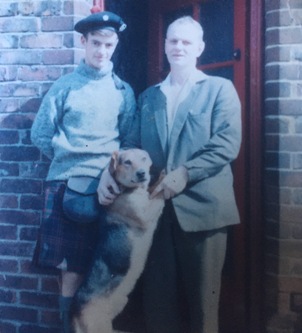 |
|
I am on the left (in the kilt) in 1967 just before a hitch-hiking trip through Europe.
On the right is my father, John, with his dog, outside 48 Dalbeattie Street.
|
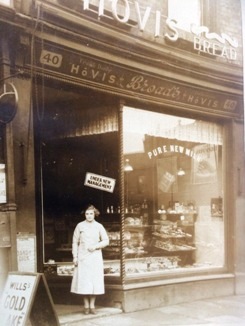 |
|
Laurie Helen MacGregor had been an apprentice confectioner before she married in 1908. Hence, the shop which I had assumed had been set up for Jean was in fact Gran's. She was separately listed in the 1933 street directory as a confectioner of Glen Villa, 108 Church Lane.
Clearly Gran had then instructed her stay-at-home daugther Jean in the art of the confectioner and baker. Here in an undated photograph we can see Jean at the door with the sign "Under new Management". I would estimate that this must have been around 1950, when Jean would be 32 and her mother aged 64.
My childish recollection in the late 1950s of Jean at the bakehouse behind the shop involved the eager anticipation of the scrapings of whatever sweetness had been prepared in the mixing bowls prior to going in the oven.
|
 |
|
This photograph must date from between 1945 and the early 1950s at Glen Villa. Grandmother died in 1957. |
|

